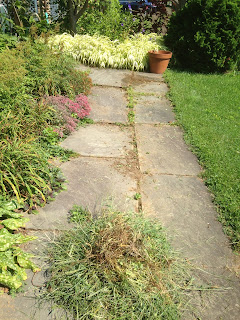American Pennyroyal - an old friend in my garden
Behind our garage there is a small garden with brick paths. It was installed by my father-in-law, Joe Louden sometime during the 1950s. At the time he created the garden it was in full sun which was very good for his hybrid tea roses. The years between then and now large Norway maple trees on the neighbor’s property have grown tall providing shade.
By the time I came to this house in 1995 the roses were not prospering. When I removed those remaining I planted flowering perennials and herbs. Most of those plants were from my prior home in Bakerville, New Hartford, Connecticut. They did not grow because the Norway Maple roots had made a thick mat in the soil.
With shade and competition I was reduced to whichever of my plants would grow. Dwarf curly chives, Allium senescens glauca, for an edger, Rudbeckia seeds from a neighbor’s garden, tough Hosta sieboldiana ‘Mrs. Allen’ were enough to make the three beds look like a garden.
In August 2017 while I was sitting weeding grass from the curly pink-flowering Alliums I found two plants growing wedged between the bricks. I was very surprised and delighted when I reached out and touched the little leaves of the plants which were only 6 inches tall. The scent of pennyroyal brought me back to my garden planted in Pine Meadow, New Hartford in 1972. It seems that my sense of smell is primal, rooted somewhere in the brain, buried deep with memories.
How could I suddenly find American pennyroyal, Hedeoma pulegioids, growing in a garden and yard where I never planted it? Those plants I grew 40 years ago would scatter their seeds and provide annual self-sown seedlings. The plant is a New England native, hardly of interest to anyone. It certainly is not at every garden center or seed company. How did it get to my garden? Perhaps the seeds came in soil around plants transplanted 20 years ago, to this garden. I will never know for certain.
My discovery of the American pennyroyal made me check my library of herb books for more information. Fortunately my mother, Bunny Foster did write about it in her 1966 book,Herbs for Every Garden, page 73, see the following:
Pennyroyal, American (Hedeoma pulegioides)
Height.1 foot
Leaf and blossom. In walking through open meadows in New England It is often possible to smell pennyroyal before you see it. The slight plant is a bit similar in leaf and habit to basil but on a more delicate scale. Every part of it is filled with the characteristic aroma of its essential oil, Oleum Hedomae. The few bluish flowers are in whorls: tiny blue, slightly hairy, two-lipped tubes circle the stem, projecting from the axils of the leaves.
Culture. Pennyroyal collected in the wild, as seeds or young plants, is worth getting started in the herb garden. Cultivation improves the plants which will self-sow for many years. Brushing against it makes weeding a fragrant job. You won’t find American pennyroyal in any catalog. The perennial English pennyroyal, Mentha pulegium, is offered as a plant by herb specialists, but the little wilding has to be your own discovery.
Habit. Pennyroyal is found in dry places from Canada southward through New England. It is usually in the company of meadow violets, wild strawberries and black-eyed susans.
Uses. The U.S. Dispensatory says that American pennyroyal is a gentle stimulant aromatic which may be given for colic and a sick stomach. It makes a pleasant tea, either fresh or dried, when steeped in boiling water. And it proves a soothing morning beverage after a night out.
Comment. Pennyroyal may some day one studied to isolate the insect repellent oil which has proven itself over centuries through empirical uses. A handful of the herb rubbed on the face and arms will protect the gardener from mosquitoes and small flies.
I read my mother’s words written over 50 years ago and still find them true.
I kept close watch on the two plants I found last summer. They flowered, seeded and provided me with dozens of new plants in spring 2018. Perhaps next year I will have enough to share with my gardening friends.




